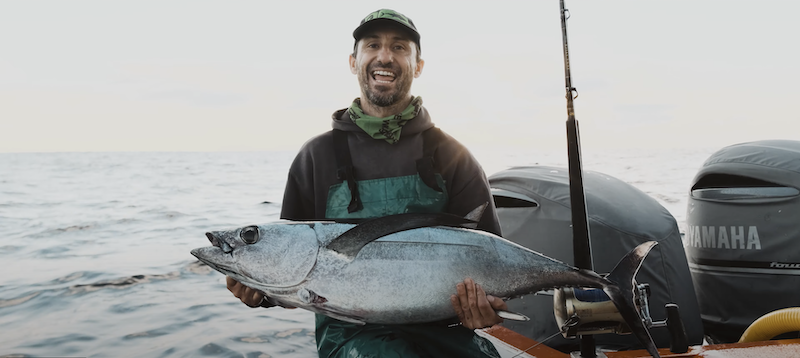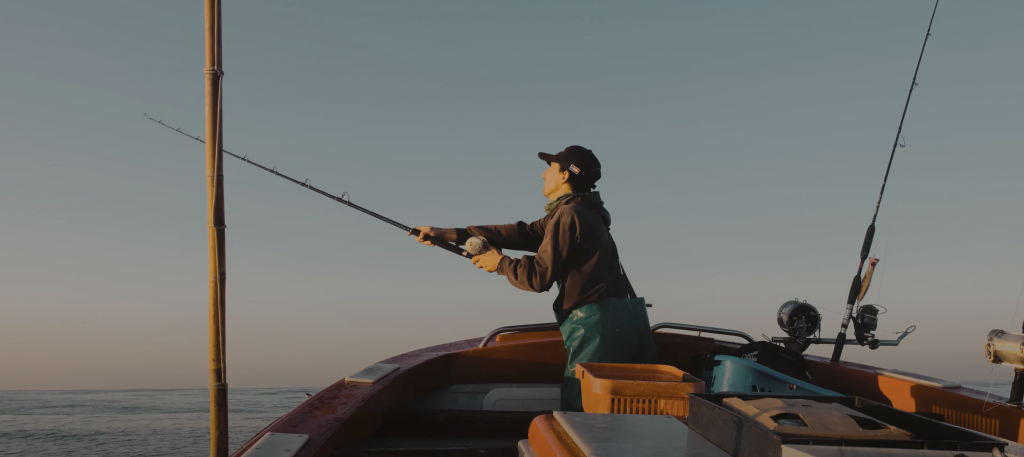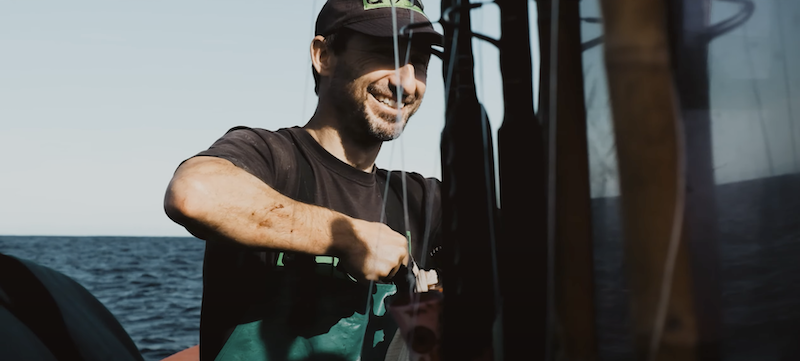Throughout coastal communities all over the globe, hundreds of small-scale fisheries are hard at work every day using ancient and traditional fishing methods to catch tuna, one fish at a time. These fisheries, which are small-scale in the size of their operations and their current market reach, produce some of the most responsibly caught and sustainable tuna in the world. They practise ‘one-by-one fishing’, a technique that uses one hook and one line to catch one tuna at a time and has wide-ranging environmental, social, and economic benefits.
The UK-based charity International Pole and Line Foundation (IPNLF) works with these types of tuna fisheries specifically all over the world, representing thousands of small-scale fishers. The one-by-one fisheries bring income and recirculate wealth among coastal communities whose local economies depend on the fishing industry. This contributes to local food security, alleviates poverty, and secures livelihoods.
The fishing techniques ‘pole-and-line’, ‘handline’, ‘troll’, and ‘rod-and-reel’ all fall under this collective term ‘one-by-one’ tuna fishing, and they bring tradition and families together through fishing. With this in mind, we couldn’t think of anyone better than Ryan Nienaber, owner of Greenfish South Africa, who uses these fishing techniques every day to tell you how one-by-one tuna fishermen like himself contribute to local economies, sustainable development, and matter on a global scale.

© Greenfish SA © Grootdors Produksies
Tell us more about Greenfish SA, yourself and how it all started?
I’ve been fishing since the age of five, and through my high school career, I used to catch linefish as a form of pocket money. After school, I started catching tuna because it paid a little bit more, and I used this to fund my studies. My lecturer at the time said, “Hey Ryan, you bunk too much class; you’re always fishing”, and I said, “Yes, but I go fishing to make money to pay for my university fees. You know, it’s kind of stuck between a rock and a hard place”. And they said, “Well, you need to have higher attendance to pass”. I said, “Don’t worry, I’ll come up with a plan”.
So, I started by buying a few tuna off the boats that I worked on and literally going door to door in and around the restaurants in Cape Town, knocking on the door and saying Hey, do you want to buy one of my tunas”? And that was the start of my trading. And I just happened to be in the right place at the right time when there was this huge sushi craze in 2003–2004, and I started my first little business out of mom’s driveway with one “bakkie” (delivery vehicle).
Then I did a major upgrade and put a chest freezer in the garage and grew it from the driveway to our factory now, which is an FDA-approved facility with 20 full-time local employees, and we are supporting the community-based fishermen that I actually grew up fishing with when I was a crew member for them. They gave me a chance as a youngster, and now I’m in a position to support them and make them more accessible to good markets.
You’ve spoken about how small-scale fisheries are incredibly important for local economies and giving back to the coastal communities – how so?
With one-by-one tuna fishing, there are many people tied to that one boat—that one fisher, me. I’m employing my crew locally. When catching tuna, we have five to six people on a boat, usually four for yellowfin and six for albacore.
Then, tied to the crew, there’s their families and the people that work in my factory, the logistics and distribution to restaurants for export, and the delivery we do to consumers—when COVID hit, we took a huge revolution in involvement and stopped supplying retailers and restaurants because they were all seized and started in the home user space. Now we deliver door-to-door and are carrying about 20 or 30 products. And that list just evolves every day. So we don’t even have a set list of what we stock. It was literally what came off the boat that day. By employing all these people, it creates a ripple effect throughout our company and supply chain, providing money and financial security to many.
Let me tell you about one of my longest-running and hardest-working employees, Tolani. One day I was fishing with my brother-in-law, and we went to catch a few bass. A stick went into my foot, and my foot was injured, and the next day I had to offload a tuna boat. We were at the traffic lights, and I saw this chap wearing a neat shirt who had written his name and his number down a million times, saying he was looking for work. I asked him if he was strong. I asked him if he was ready to work harder than he has ever worked in his life. He said “yes” to all, so I said “jump in,” and I have never looked back. We sat in a vehicle together for five years, and he is one of my absolute champions in the office today. He came from a shanty town and now owns a flat. Upliftment doesn’t have to come from your community; it can come from your business too.

© Greenfish SA © Grootdors Produksies
How do one-by-one tuna fishers contribute to sustainable development?
With more than 20 or 30 years worth of hands-on experience in and on the water, we have put ourselves in the position we are in today. We need to look after the tuna that we catch; our philosophy is to catch a little and look after it to its maximum value. In my opinion, you should not be killing fish if you are not going to honour it and look after it. Fishing one-by-one allows tuna species to flourish; small-scale fishermen take out a percentage of a school of fish, allowing the others to go on and breed for the following years. In comparison, large industrial methods that take out entire schools of fish and anything else that may be in the way decimate the entire school, eliminating any future breeding potential. One-by-one fishing techniques are the only low-impact techniques that I agree with for catching tuna.
On my boat, I use all three techniques (pole-and-line, trolling, and rod-and-reel) on any given day. For example, I start the day by trolling to find a school, then I start poling on the side, then I go into rod-and-reel. We’re one of the few that use all three; in the USA, for example, there are boats that only use troll methods, and in the Maldives, there are boats that only use pole and line. Handline is a different technique, which I use depending on the species and season. But with all techniques, you have zero to no bycatch, so you leave other species in the ocean. The chances of catching juvenile fish and thus contributing to overfishing are incredibly small, so you leave the opportunity for the fish to reproduce. There’s little contribution to plastic pollution coming from our fishing gear, and we are helping South Africans better understand what they are eating, where it comes from, and how it was caught. We catch the fish right here at our doorstep.
How does one-by-one fishing and / or the fishers ensure global food security?
One-by-one, tuna fishers use their catch to feed their local communities, like we do here in South Africa, as well as supply international markets with tuna products. These fisheries play a vital role in the global tuna supply chain, especially when considering the growing demand for ethically sourced and eco-conscious consumer products. I know that industry says “pole-and-line can’t feed the world,” but it can, and it is already doing it to a large extent; all over the world, people use their natural resources and feed off the ocean. In the Maldives, they eat tuna three times a day!
Since one-by-one fishermen cause little harm to the waters in which they fish, positioning these fisheries for market success creates significant environmental benefits. Catching fish isn’t any different; the only difference is that you have to do it in balance with nature and with respect for the fish that you take from the ocean.
We champion the way our fish are caught and the low impact this has on our ocean environment. One hook, one line, catching one fish at a time Handline fishing methods are often overlooked as they are deemed “small-scale” or not economically viable for big corporations. However, this method of fishing has many benefits for our oceans and, done right, can be produced ethically and economically viable for export. We demonstrated that in Oman last year. Handline does not damage habitats or seabeds like some other industrial methods with large nets. Most importantly, local communities are empowered. Local ownership and tradition have been passed down by generations, and a community is bonded by the ocean they have become custodians of.

© Greenfish SA © Grootdors Produksies